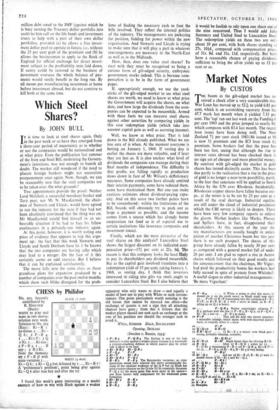CHESS by Philidor
No. 305. Specially contributed by R. HANCOCK (Bucks) yawn to play and mate in two moves; solution next week. Solution to No. 304 (Rice) : Kt - R no threat. r .. Kt - Q 6; 2 P - B 4. x...KtxP; 2 Q X Kt. I ... Kt else ; 2 P - B 3. . . . B any ; 2 RxKt. Note the thematic try I P - B 3? with main variation . . . WHITE (9 men) Kt - Q 6 ; 2 Kt - Q 4. but defeated by .. Kt - B 7 ! A 'problemises problem', point being play against Kt - Q 6 after true key and after the try.
I found this week's game interesting as a model example of how to win with Black against a weaker
opponent who only wants to draw — and equally a model of how not to play with White in such circum- stances. One point particularly worth noticing is the old lesson that cannot be stressed too often—the exchange of queens is not a sign that all attacking chances have gone ; from this it follows that the weaker player should not seek such an exchange at the cost of his position nor should the stronger seek to avoid it.
White, STERNER Black, BOLFSLAVSRY Opening, Sicxmax
(Sweden v. Russia, 1954)
r P- K 4 P-984 The Sicilian is one of the best
defences to play against a weaker player because it is essentially a counter-attacking defence in which passive play by either side is likely to be fatal. 2 Kt-KB3 Kt-QB3 3 P - Q4 PxP
4 Kt x P Kt - 8 3 5 Kt -A.9 B 3 P- t5 B - P- 4 The Boleslaysky variation; an older generation would have teiected this move automatically be- cause of the resultant weakness of the Q P but (a) Bledc has good counter-chances on the Quid* (b) he •Untly threatens - Q 4 (c) the move gains huts more space in the centre— and these factors fully compensate for the weakened pawn formation.
7
8 0 - 0 Q-Da 9 B - K 3 B-1C3 ro P -13 4 . . . if White is going to play this move, he should do it on the ninth move, as Black could now reply TO . P x P; tz BxP transposing into the variation 9 P- B 4, P xP; so B xP, B -K 3 with a move in hand. so B- B 3, piling up on Q 5 is better.
ro . P - Q R 4 Rather surprisingly allowing P - 5, Perhaps with the line t r P-B 5, B - Q a; I2 P - Q R 4, Kt - Kt 5 and 13 . B - B 3 in mind. ir PxP. P.. This and his next two moves constitute a miserable attempt, which meets with well-deserved punish- ment, to simplify down to a draw.
PxP 12 QxQ ch K RxQ
13 r3 Kt -B is better: now Black gets a strong, probably winning, initiative. Kt - Q Kt 51 ▪ RxR eh BxR1 Much better than the obvious R x R.
r5 B - Q 3_ • . • After rg R-Q B z either _(2) rg . . .
P - Q Kt 3 threatening P - R 5 P -Q R 4, Kt xB P) or (b) z 5 P - R 5; 16 Kt - B 5, B - Kt 3 as very strong.
Kt - Q a . .
P - 51
r6 and not z6 Kt - B 5?, B - Kt 3I with the :6 double threat of *Kt R 6 1 Kt 5 and Kt - Q a. ry. . . P- P- Q Kt 3 Kt - Kt g • B- 5 Kt x13
29 P x Kt R - B r 20 B - Kt 4 B - Kt 3 eh
or K -B . K - R z Kt - B 7 cis; K - Kt z, Kt )5Q P ch sz.iden.._. Kt x B. ar Kt-K6 6 eh 22 K -K Kt - B 7 23 Resigns.


































 Previous page
Previous page